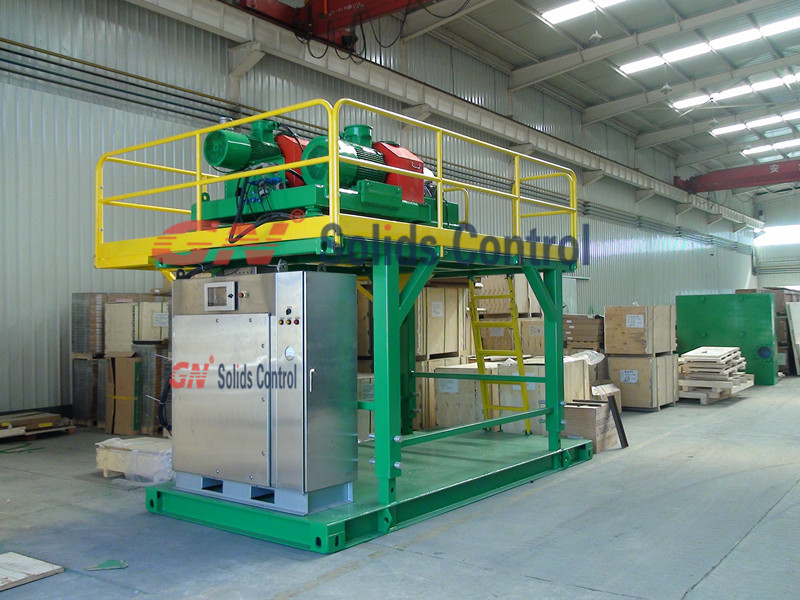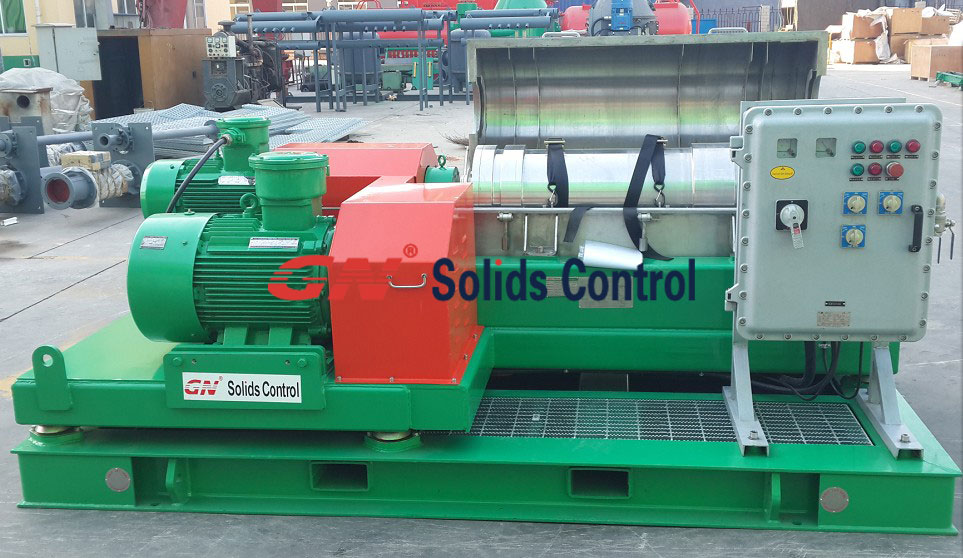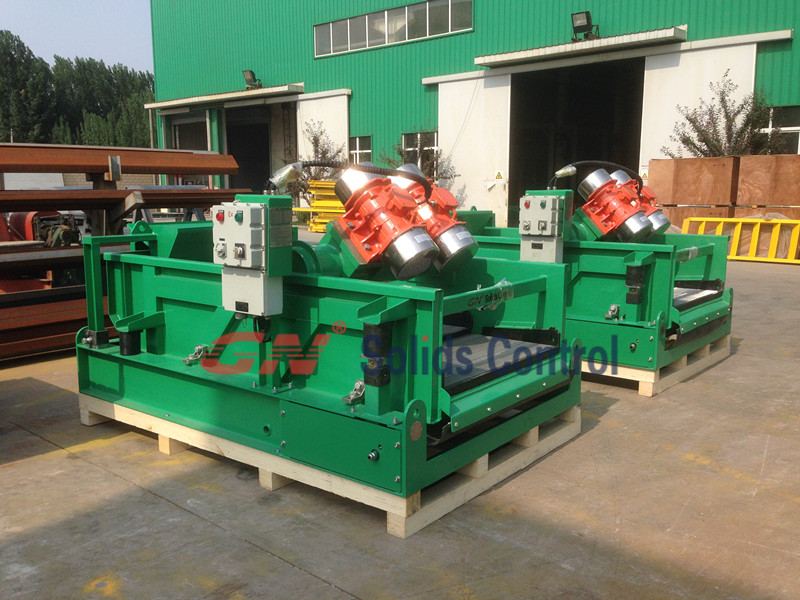
Decanter centrifuge is usually installed after the desilter. The drilling mud from the desilter is pumped through the inlet to the feed chamber and slung from the feed ports into the pool. It is accelerated again with a high shearing effect due to the rotation of the bowl. The level of the pool is determined by adjustment of the weirs at the large end of the bowl (effluent discharge).
As the slurry flows through the pool in the channels between the conveyors flights, the particles settle according to Stocke's law, but at an accelerated rate due to the higher G forces. Sand particles settle almost instantly, then the finer particles settle. The particles that cannot be settled under the existing settings of the centrifuge will discharge out the overflow with the liquid phase (effluent).

The screw conveyor rotates in the same direction as the bowl, but at a slightly slower rate. This difference is determined by the gear box. Typical gear boxes are 80:1, 125:1, 40:1, and 52:1 gear box. 125:1 means that for every 125 revolutions of the bowl, the conveyor turns one less or 124. With this ratio, a centrifuge rotating at 1800 RPM has a conveying speed of 1800/125=14.4 RPM.
The settled solids from a cake on the side of the bowl and are conveyed along the outer edge of the pool towards the solids end (small end) of the rotating assembly and are discharged out the solids discharge ports at high velocity. As the solids travel across the beach, they lose their free liquid film due to centrifugal squeezing and drainage. They are discharged with only the absorbed moisture; provide the centrifuge is operated properly.
This discharge cake is very heavy, and sticky. It will not flow because of the lack of free liquid. It is important to realize this when installing a centrifuge. If possible, install over the place where the solids are to be discharged. If this is not possible and this slide so that it will self clean. If this is not possible, then some sort of mud wash or water wash will be needed to keep the solids from building up and packing off the centrifuge. Another option is a small amount of remix water added within the bowl housing directed at the solids discharge to softed the slurry. Remember to have the solids directed towards an mud agitator to keep the solids from simply dropping to the bottom of the mud tank.
- Details
-
Published: 28 June 2014
A decanter centrifuge operates on the principle of accelerated settling. Particles will settle in a viscous media according to stoke’s low, which in simple form is written as follows:
If a sphere settles in a liquid of known density and viscosity, and the settling rate is measured, then by stokes low the density of the ball or sphere can be calculated if the diameter is known. Or. The diameter can be calculated assuming the density is known.

GN Decanter Centrifuge
Since in the real word, we don’t drill spherical balls, we use the equivalent spherical diameter of the irregularly shaped particles, which enables us to use stoke’s law. When the settling rates of irregularly shaped particles are measured in a liquid with known density and viscosity, the E.S.D can be calculated, assuming or knowing the specific gravity of the particles.
Two particles of the same ESD, but different specific gravities, will settle at different rates. The heavier particle will settle faster. Two particles of different specific gravities will settle at the same rate if their ESD difference compensates. A barite particle will settle at the same rate as a low specific gravity particle if its ESD is 1.5 times that of the barite particle.
With this in mind, it is importance to screen to 200 mesh (74 microns d50) with you shaker, or mud cleaner, prior to sending mud to a centrifuge with a weighted mud. This will minimize the solids drilled solids in the discharge which is returned to the active mud system.
- Details
-
Published: 21 June 2014
A decanter centrifuge is a device that creates a centrifugal force, and imparts that centrifugal force to its components by rotation.
The centrifugal force created by the centrifugal is dependent on the diameter and RPM of the bowl. To calculate the g force, use the flowing formula:
“g†force for centrifuge
G’s = RPM2(0.0000142)(Diameter of bowl, inches)
Example: 24†bowl, 1530 rpm
G’s = (1530)2(0.0000142)(24)
The performance of a centrifuge for a given mud is dependent on the following factors:
1. The g’s exerted on the fluid
2. The retention time in the centrifuge (the longer the mud is in the centrifuge the smaller the particle that can be separated)
3. Conveyor differential (the faster the differential, the wetter the solids and the more solids are discharged)
All of the above are factors which are considered in different designs. Some designs perform better for different applications. Designs often vary in bowl diameter, length, RPM operating range, gear ratio, pool depth. Etc.
The items which can typically be manipulated in a centrifuge operation are the feed rate and dilution (if any), the gear ratio (by changing gear box), the pool depth (by changing the weir settings), and the rpm (by changing the sheaves), which changes the g force.

To calculate the RPM of a centrifuge, use the following method:
RPM of a centrifuge
RPM=(size of motor’s sleave/size of rotating assembly)x rpm of motor
GN centrifuge has the small capacity and big capacity for your choice in different applications. More solids control equipment at GN solids control
- Details
-
Published: 15 June 2014
Recently, four units decanter centrifuge and two units Hi-G dryer shaker are to be dispatched for drilling waste management in Africa and Middle East. Drilling waste disposal has become a crucial part of drilling contractor, as the environmental regulations require a clean and safe disposal through out every country.

Decanter Centrifuge to Africa Drilling Company
Many drilling companies are more likely to buy the decanter centrifuge themselves for their solids control and first stage waste cuttings drying, because the price of decanter centrifuge is not that high as before. GN centrifuges are reasonable in price and excellent in performance and quality. It will save much for the drilling company when compared with centrifuge rental from solids control service company. The African drilling company ordered:
2 units x GNLW363BG, high speed centrifuge with a fixed speed of 3200RPM.
2 units x GNLW363BG-VFD, Variable speed decanter centrifuge with PLC and VFD electric control system. It is equivalent to Derrick DE1000FHD and MI-SWACO 518HV.

Hi-G Dryer shaker to Middle East
With advanced GN Hi G technology, the Hi-G dryer shaker is efficient in recovering more oil based drilling fluids and the Oil On Cuttings (OOC) figures is significantly reduced. Another benefit is the elimination of whole mud losses from the traditional shale shaker. So with the use of Hi G dryer shaker in the down stream of mud system, it can allows the shakers to run at their maximum capacity without the concern of the mud loss of the mud system. This is why the Middle East drilling contractor cone to us for the Hi G dryer for their existing mud system.
- Details
-
Published: 07 June 2014
One set of decanter centrifuge package is now ready to deliver to Kuwait for oil sludge treatment. We have meet with the client for several times at CIPPE 2014, Beijing and OTC 2014 and finally come to our factory for signing the contact. Decanter centrifuge separation is just part of oil sludge treatment. This time the client require a VFD centrifuge for their current project.

Oil Sludge Treatment Decanter Centrifuge Package
1 x Decanter Centrifuge, GNLW363BG-VFD
1 x Centrifuge Skid with operation platform

Features of GN VFD + PLC Decanter Centrifuge
â— VFD (Variable Frequency Drive) Decanter Centrifuge
â—Controlled and monitored by a Programmable Logic Controller (PLC). Requires fewer operating personnel and features automatic adjustment for different operating conditions
â— Patent Design with the highest configuration and best material for long and reliable service
â—Bowl Cylindrical and Conical section made from Duplex Stainless Steel 2205 by centrifugal casting
â—Other Parts of the bowl assembly material: stainless steel SS316L
â—Screw protection: Tungsten Carbide Tiles for longer life and easier replacement
â—Screw flow distribution port and bowl solids discharge port protected by tungsten carbide alloy
â—Easily adjustable liquid discharge weir height for flexible application
â—Bowl assembly supported by tighten belt for protection of bearing in moving
â—Genuine SKF bearing for longer and reliable operation
- Details
-
Published: 31 May 2014
The purpose of the decanter centrifuge as applied to a weighted water-base drilling mud is to control viscosity. This is accomplished by concentrating the colloidal-size and clay-size solids fraction into the effluent (liquid) steam and disposing of this phase. The economic justification of using the centrifuge on this type of system is the simultaneous return of weight material. Using a centrifuge on weighted water-based muds eliminates the expense of throwing away (jetting) whole mud to control viscosity. Water dilution and excess waste volume are minimized.

* Add enough dilution water to reduce the effluent viscosity to 35-37 sec/qt marsh funnel viscosity. If the overflow is 37 sec/qt or less without dilution, none is needed.
* Operate the decanter centrifuge at a slower feed rate for longer periods to maximize efficiency and provide a more homogeneous mud system. It is better to run the centrifuge for eight hours processing 10 gpm than for four hours processing 20 gpm.
Weighted Oil-Base Muds
Single centrifuges have typically been run to control viscosity only on weighted water based muds. On an oil base mud system, the cost of discarding the fluid phase and chemicals with the colloidal solids can be prohibitive.
GN centrifuges are properly designed for oil and gas drilling operations, please contact GN centrifuge for more information.
- Details
-
Published: 24 May 2014